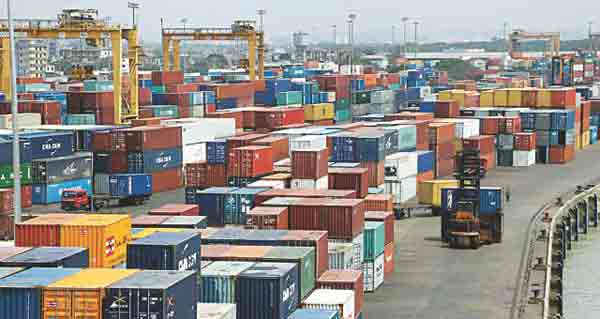

Chittagong port of Bangladesh
Dhaka, Bangladesh (BBN)- Bangladesh overall trade deficit reached nearly $4.0 billion in the first quarter (Q1) of this fiscal year due mainly to higher import payments than lower export receipts.
The gap in the country’s trade with the rest of the world rose to $3.85 billion in the July-September period of fiscal year (FY) 2018-19 from $3.65 billion in the same period of FY 18.
The deficit registered 5.53 per cent growth during the period under review, according to the central bank’s latest statistics.
Talking to the BBN, a senior official of the Bangladesh Bank (BB) said higher export growth helped reduce the trade deficit during the period under review.
Export earnings rose by 14.01 per cent to $9.75 billion during the Q1 of FY ‘19 against $8.55 billion in the same period of FY ‘18.
On the other hand, the overall import grew by 11.48 per cent to $13.60 billion during the same period.
It was $12.20 billion in the same period a year earlier, the BB data showed.
The central banker also expects that the trade deficit may narrow down further in the coming months if the rising trend of export earnings continues.
Meanwhile, the overall export earnings jumped by 30.53 per cent to $3.71 billion in October 2018 from $2.84 billion in the same month of 2017, The Export Promotion Bureau data showed.
Senior bankers, however, said the overall imports may maintain ‘slower growth’ because of the upcoming election but higher imports of fuel oil may continue.
“Most of the businessmen are now adopting a ‘wait-and-see’ policy in setting up fresh industrial units for expanding their business ahead of the general election,” Syed Mahbubur Rahman, chairman of the Association of Bankers, Bangladesh (ABB), told the BBN.
The existing downward trend in capital machinery imports may continue ahead of the polls, added Mr Rahman, also managing director and chief executive officer of Dhaka Bank Limited.
Import of capital machinery or industrial equipment used for production, dropped by 3.39 per cent to $1.24 billion in the Q1 of FY 19 from $1.29 billion in the same period of the previous fiscal.
On the other hand, higher export earnings growth along with an upward trend in remittance inflows has helped reduce current-account deficit during the period under review.
Bangladesh’s current-account deficit came down to $1.35 billion during the July-September period against $1.82 billion a year ago, the BB data showed.
The inward remittance, however, increased by 14.10 per cent to $3.87 billion in the Q1 of this fiscal from $339 billion in the same period of the FY 18.
The BB data showed the country’s overall balance of payments (BoP) is still in negative territory despite lower current-account deficit.
The BoP deficit rose to $720 million in the first three months of FY ‘19 against $360 million in the same period last year.
Talking to the BBN, another BB official said lower surplus in the financial account has pushed up the overall BoP in the Q1 of FY 19.
Surplus in the financial account came down to $793 million during the July-September period of FY ‘19 from $1.59 billion the year before.
“Surplus in the financial account dropped significantly mainly due to fluctuation of assets and liabilities of the commercial banks,” the central banker explained. “It may improve shortly.”
The higher inflow of foreign direct investment (FDI) has continued during the period under review, although portfolio investment deceased slightly.
The gross FDI inflow grew by 7.95 per cent to $720 million in the Q1 of FY 19 from $667 million in the same period of FY 18.
Besides, the net FDI inflow increased 9.63 per cent to $330 million from $301 million.
On the other hand, portfolio investment came down to $29 million from $157 million.
BBN/SSR/AD